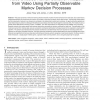Free Online Productivity Tools
i2Speak
i2Symbol
i2OCR
iTex2Img
iWeb2Print
iWeb2Shot
i2Type
iPdf2Split
iPdf2Merge
i2Bopomofo
i2Arabic
i2Style
i2Image
i2PDF
iLatex2Rtf
Sci2ools
PAMI
2007
2007
Value-Directed Human Behavior Analysis from Video Using Partially Observable Markov Decision Processes
—This paper presents a method for learning decision theoretic models of human behaviors from video data. Our system learns relationships between the movements of a person, the context in which they are acting, and a utility function. This learning makes explicit that the meaning of a behavior to an observer is contained in its relationship to actions and outcomes. An agent wishing to capitalize on these relationships must learn to distinguish the behaviors according to how they help the agent to maximize utility. The model we use is a partially observable Markov decision process, or POMDP. The video observations are integrated into the POMDP using a dynamic network that creates spatial and temporal abstractions amenable to decision making at the high level. The parameters of the model are learned from training data using an a posteriori constrained optimization technique based on the expectation-maximization algorithm. The system automatically discovers classes of behaviors and deter...
Related Content
| Added | 27 Dec 2010 |
| Updated | 27 Dec 2010 |
| Type | Journal |
| Year | 2007 |
| Where | PAMI |
| Authors | Jesse Hoey, James J. Little |
Comments (0)

